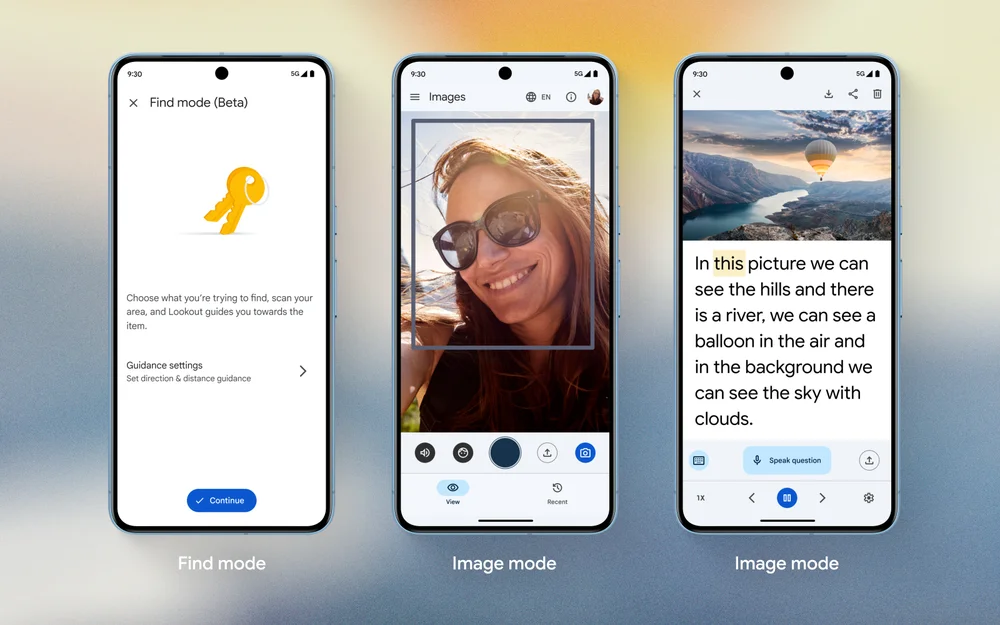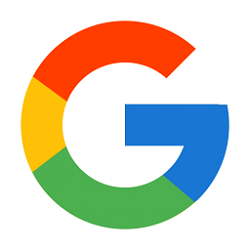8 new accessibility updates across Google products and platforms
- Find objects around you easily and capture images with Lookout. Lookout on Android helps people with blindness and low vision use their phone’s camera to get more information about the world around them. Today, Find mode is rolling out in beta, providing a new way to find specific objects. Select from seven categories of items — like seating and tables or bathrooms — then as you move your camera around the room, Lookout will notify you of the direction and distance to the item. Earlier this year, AI-generated image captions became available on Lookout globally in English. Now if someone captures a photo directly within the app, they’ll receive an AI-generated description of the image and learn more about the images they take.

Lookout's Find mode and Image capture button help you get more information about the world around you - Use a text-free mode to communicate using Look to Speak. With the Android app Look to Speak, you can select pre-written, customizable phrases with your eyes and have them spoken aloud. Starting today, Look to Speak is rolling out a text-free mode. With this mode you can also select and personalize emojis, symbols and photos to activate speech. This new feature is based on feedback from the community to help make communicating more accessible with cognitive differences, literacy challenges and language barriers.
Use Look to Speak text-free mode to communicate with images and symbols - A hands-free cursor for Android Developers. Last year we released Project Gameface, an open-source, hands-free gaming mouse, on PC. Starting this week, developers can now access Project Gameface for Android devices via Github. With the help of Accessibility Service for Android and Google MediaPipe, developers can build applications that let users customize facial expressions, gesture sizes, cursor speed and more. Through collaboration with Incluzza, a social enterprise in India that supports people with disabilities, we were also able to learn how Project Gameface can be expanded to educational, work and other settings, like being able to type messages to family or searching for new jobs.
- Receive more detailed walking instructions and learn more about the world around you with Maps. For those who are blind or low-vision, we’re expanding detailed voice guidance and screen reader capabilities for Lens in Maps to Android and iOS globally in all supported languages. With screen reader capabilities for Lens in Maps, you’ll hear the name and category of places around you — like ATMs, restaurants or transit stations — and how far away a place is so you can quickly orient yourself and decide where to go. And when you’re walking and can’t see your phone, detailed voice guidance provides audio prompts letting you know when you’re heading in the right direction, crossing a busy intersection, or being rerouted if you’ve gone the wrong way.
- Get Accessibility information no matter where you search. Maps now has accessibility information for more than 50 million places, thanks to contributions from business owners and members of the Maps community. The ♿ icon indicates a place with a wheelchair-accessible entrance with more details about accessible restrooms, parking and seating under the About tab. The ♿icon was previously available worldwide on Android and iOS, and is now expanding to desktop so you can easily find this information no matter where you’re searching. And now when you’re viewing a place on mobile, you’ll also be able to filter reviews to easily find helpful information about wheelchair accessibility.
- Find places that can cast to your hearing devices. For those in need of hearing assistance, business owners can now add the Auracast attribute to their business profile. Auracast broadcast audio allows venues — like theaters, gyms, places of worship, and auditoriums — to broadcast enhanced or assistive audio to visitors with Auracast-enabled Bluetooth hearing aids, earbuds and headphones. Learn how to add this attribute to a business profile here.
- Customize how you teach Project Relate. In 2022, we launched Project Relate, an Android app for people with non-standard speech, that allows you to create a personalized speech recognition model to communicate and be better understood. Custom Cards allow you to customize the phrases you teach the model so it understands words that are important to you. Now, there’s a new way for you to select text and import phrases from other apps as Custom Cards, like a note in a Google Doc.
- New design for Sound Notifications with feedback from you. Sound Notifications alerts you when household sounds happen — like a doorbell ringing or and a smoke alarm going off — with push notifications, flashes from your camera light, or vibrations on your phone. We’ve redesigned Sound Notifications based on user feedback, improving the onboarding process, sound event browsing, and making it easier to save custom sounds for appliances.

8 new accessibility updates across Google products and platforms
Posted: 16 May 2024
Today is Global Accessibility Awareness Day, a day dedicated to talking, thinking and learning about digital access and inclusion for the more than 1.3 billion people with disabilities around the world. Here’s a look at eight new accessibility features we’re rolling out across our products and platforms — built together with and for people with disabilities.
AI-powered accessibility updates for Android
In addition to announcing Gemini’s integration with TalkBack this week, we are creating new accessibility tools using AI and integrating them into your mobile experiences.
The Project Gameface team worked with Incluzza to learn how the open-source cursor could be more helpful for people with disabilities
Expanded accessibility features in Maps
To make Maps even more helpful for people with disabilities, we’re expanding access to features and offering new options for businesses.
The Maps team working on Accessibility and Disability Inclusion recently met with the USA Wheelchair rugby team to discuss shared experiences with disability.
New designs for Project Relate and Sound Notifications
We’re committed to an ongoing partnership with the disability community to improve our accessibility features, including updates based on user feedback.
https://blog.google/outreach-initiat...ate-gaad-2024/
Related Discussions

